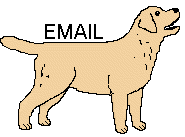Kids & Dogs
Although Hollywood and television often portray dogs with human thoughts, values and even words, it is important to remember that your dog is not a person. Dogs have different needs than humans do. One important element in a dog's life is his need for a pack hierarchy. Your family is now your dog's pack and you (the adult family members) must be your dog's pack leader (the alpha wolf). Without this leadership, your dog will assume leadership and not only become obnoxious , but will try to "run the pack" which can (and often does) lead to disastrous results.
The first thing you must do is set some house rules (e.g. no begging, no jumping on people or furniture, no chewing, ect.) Include all family members in setting these rules so that they know what is allowed and what is not. Consistency is very important. Everyone must follow the same set of rules. Inconsistency (Mom says it's OK, Dad says it isn't) will only confuse the dog and lead to behavior problems. Teach your dog the rules by firmly but gently discipline him for breaking them, and lovingly praising proper behavior.
The next thing you must do to assume leadership with your dog is take your dog to obedience school. An ill-behaved dog is a nuisance to you, your family and guests; plain and simple. You cannot control your dog if he doesn't know or won't obey basic obedience commands. Most areas offer puppy kindergarten classes which are set up for very young dogs whose attention span is short. They will learn basic commands and how to follow them with distractions around them. Life will be easier, with an obedient dog.
Children under the age of two really aren't aware of the dog as a real presence. Although they may talk to the dog and call it by name, the dog doesn't really mean any more than a stuffed animal. At this age the dog considers the child a potential littermate. Playing with the child as it would a puppy from its own litter. You must teach the child to respect the dog and the dog to behave properly with the child.
Supervision is mandatory whenever an infant and dog are together. Playpens (for kids) and crates (for dogs) are very useful tools to separate dogs and infants. Reward your dog with praise for tolerating toddler play ( patting, crawling around, ect.). Teach your child appropriate ways of interacting with your dog (petting vs. hitting). Separate the child and dog if play gets to rough or you feel the dog is getting tired or uncomfortable.
Don't relegate your dog to the back yard. He is a family member and deserves and needs to be with you. Behavior problems won't be corrected by barring the dog from the house. Take time to spend a few minutes of quality time with your dog each day. Even if it is only a walk around the block.
Allow the dog into the nursery. Teach them to come in and down stay while you are busy. Keeping them out of the nursery can create jealousies.
At this age, children view the dog as a playmate sometimes and a nuisance at other times. The dog still views the child as a littermate. You should be prepared to intervene with a child who is abusing the dog (hair pulling, ear yanking ect.) The dog should tolerate a little of this, but don't expect the dog to become your child's punching bag.
Teach the child appropriate games such as "fetch" and "hide and seek" that they can play with the dog. Games should avoid roughness and tug-o-war as these can lead to injuries to both parties. If children are over visiting, with a lot of running and screaming, the dog would probably be more comfortable in a quiet place away from it all.
Monitor all interactions between the dog and your child. Show your child how to gently correct the dog if it is old enough to understand when it is appropriate. If not, then you will have to be the one to intervene when the puppy needs correcting.
At this age children can begin to show leadership and responsibility with your dog. This is a good time to have your child participate in the care of your dog (feeding, walking. and training). Children of this age can make excellent trainers, they are usually more consistent and playful in their training.
Include your child in obedience training, if the instructor will allow the child to be in class, have them do the training. Sometimes the trainer wants an adult teaching the dog, in that case take your child to the class to watch so they can help with the training at home.
Assigned chores based on the child's ability, it can help them learn the responsibility of a dog. Always follow up to make sure the child is doing the job right. Never let children assume full responsibility for a dog's care. A dog needs much more time and attention than a child can reasonably give. If you don't want the responsibility for a dog's care, DON'T GET A DOG!
At this age children can become more interested in their own activities than the dog. This is normal and can be expected. The adults should be prepared to give the dog more attention as your child starts spending more time with friends and social activities.
 Recommended Reading
Recommended Reading
 Click here to go to J-B Wholesale Pet Supply to order your pet supplies.
Click here to go to J-B Wholesale Pet Supply to order your pet supplies.
